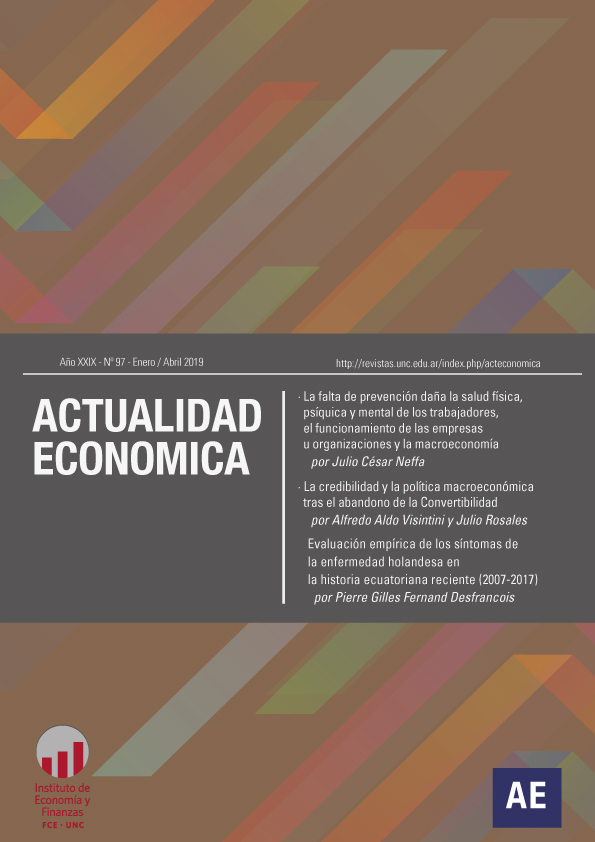Empirical Evaluation of the Symptoms of Dutch Disease in Recent Ecuadorian History (2007-2017)
Keywords:
Macroeconomy, Dutch disease, Empirical evaluation, Public politics, Oil BoomAbstract
The present research work develops a model of autoregressive vectors (VAR) to evaluate the hypothesis of Dutch disease in the Ecuadorian economy in the last decade based on the available historical data (2000-2017). The main symptoms of this economic phenomenon were analyzed empirically. The methodology used was a VAR model that collects the interactions between the main economic variables. The impulse response functions were estimated to measure the symptoms of the Dutch disease in Ecuador. The methodology allows to quantify the impact of the oil boom on the dynamics of the Ecuadorian economy. The results reaffirm the vulnerability of the national economic dynamics with respect to the volatility of oil revenues. It is estimated that the oil boom causes an income effect, since the oil bonanza has been a determining factor in explaining the country's economic growth, and an expenditure effect that led to an appreciation of the real exchange rate that discourages the activity of the tradable sector of the country. In addition, there are tensions on public finances through increased public spending and the trade balance due to the increase in imports, concluding that the oil boom caused fiscal and commercial imbalances in the country.
Downloads
References
Acosta, A. (2011). Extractivismo y neoextractivismo. Dos caras de la misma maldición. Más allá del desarrollo, Miriam Lang y Dunia Monkrani (Eds.): 83-118. Quito: Abya Yala
Banco Central del Ecuador. (2016). Información Estadística Mensual No.1978 - Diciembre 2016.
Bresser-Pereira, C. (2008). "The Dutch disease and its neutralization: a Ricardian approach". Brazilian Journal of Political Economy 28(1):47-71.
Campo, J., y Sanabria, A. (2013). "Recursos naturales y crecimiento económico en Colombia: ¿maldición de los recursos?" En Perfil de coyuntura económica (pp. 17-37). Universidad de Antioquia.
Caria, S. (2017). "El petróleo en Ecuador, 2000- 2015 ¿maldición, bendición o simple recurso?" Revista Iberoamericana de Estudios del Desarrollo, 6(2), 127-147.
Carrión, F., Kingman, E., y Vargas, G. (2002). "Sobre bonanzas y dependencia Petróleo y enfermedad holandesa en el Ecuador". ICONOS, (13).
CEPAL (2015). "Panorama Fiscal de América Latina y el Caribe 2015. Dilemas y espacios de políticas". Cepal, Santiago de Chile.
Corden, W.M. y Neary, J.P. (1982). "Booming Sector and De-industrialization in a Small Open Economy". The Economic Journal, Vol.92, No. 368, pp. 825-848.
Creamer, B. (2015). "Las bonanzas petroleras y la enfermedad holandesa en la economía ecuatoriana". Boletín Estadístico del Sector de Hidrocarburos. Petróleo al día, 4(1).
Harding T., y Venables A. (2013). "The Implications of Natural Resources Exports for Non-Resource Trade". Research Paper 103. Oxford Centre for Analysis of Resource Rich Economies, Oxford.
Jurado, C., Bejarano, H., Salcedo, V., y Sánchez, M. (2017). "La volatidad del precio del petróleo: sus efectos en la economía ecuatoriana en la última década". 3C Empresa: investigación y pensamiento crítico, 6(2), 33-45
Leon, M. (2016). "Diagnóstico y perspectiva de la economía ecuatoriana en 2016". FES-Ildis, Quito.
Naranjo, M. (1995). “La Enfermedad Holandesa y el caso ecuatoriano”. Cuestiones Económicas No. 24, Banco Central del Ecuador.
Ocampo, L. (2005). “Manejo Optimo de la Enfermedad Holandesa para Ecuador”. Cuestiones Económicas. Banco Central del Ecuador.
Sims, C. (1980). "Macroeconomics and Reality". Econometrica, 48(1), 1-48.
Perry, G., y Olivera, M. (2010). "El impacto del petróleo y la minería en el desarrollo regional y local en Colombia". Fedesarrollo.
Vera, L. (2009). “Cambio estructural, desindustrialización y pérdidas de productividad: evidencia para Venezuela”. Cuadernos del CENDES, Año 26, No 71, Mayo-Agosto.
Downloads
Published
Issue
Section
License
Those authors who have published with this journal, accept the following terms:
Authors will conserve their copyright and guarantee the magazine the right of first publication of their work, which will be simultaneously subject to the Creative Commons Attribution-NonCommercial-NoDerivative 4.0 International License that allows third parties to share the work as long as the author and first publication of this magazine are indicated.
Authors may adopt other non-exclusive license agreements to distribute the published version of the work (e.g., deposit it in an institutional telematic archive or publish it in a monographic volume) provided that the initial publication in this journal is indicated.
Authors are allowed and encouraged to disseminate their work through the Internet (e.g., in institutional telematic archives or on their website) before and during the submission process, which may lead to interesting exchanges and increase citations of the published work. (See The effect of open access)









